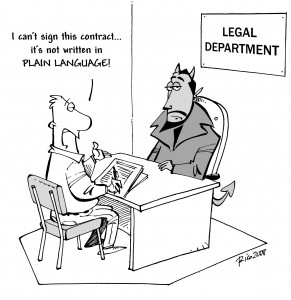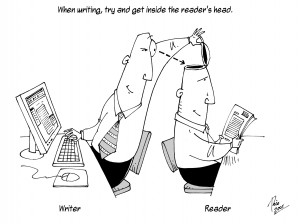Are you ready to be held to your brand promise in a new era of consumer rights?
| Simplified White Paper: Transparent communication is an opportunity to sharpen innovation, competitiveness and customer-centricity, repositioning your brand for an age of growing consumer power and tighter regulation. |
Executive summary: from plain English compliance to customer-centric innovation
A shifting legal and regulatory landscape, coupled with rising consumer expectations, means that organisations need to close any gaps between their presales promise and the post-sales reality. This will demand close collaboration between sales, marketing, legal and compliance teams as businesses strive to align their communications with regulators’ and consumers’ insistence on clarity, fairness and understandability.
Organisations are forced to comply with legislation such as the Consumer Rights Act and (in certain industries) regulatory frameworks such as Treating Customers Fairly (TCF). Rather than seeing such laws and regulations as a burden, leading organisations should treat them as an opportunity to turn fair and transparent communication into a competitive edge.
Those that go beyond the minimum prescriptions of the laws and regulations to write in plain English have an opportunity to revitalise their products and brands, and to forge closer relationships with their customers. They may also be able to reorient their businesses around more customer-centric communication, as well as more effectively sell complex and innovative products and services to the market.
To take the gap, companies need to drive culture change to ensure closer alignment of the brand promise and legal delivery. Critical steps are to build skills through training programmes, to map progress through comprehensive audits of communications, and to identify priorities and quick-wins.
A new era of consumer rights
“UK consumers spend £90 billion a month. Transparent rights will help them to make better choices when they buy and save them time and money.” – Citizens Advice
The advent of the Consumer Rights Act – most of which came into force from 1 October 2015 – is just the latest development in the rapid and ongoing transformation of the consumer landscape in Britain. Social media activism, regulatory intervention, and an increasingly empowered and informed consumer all mean that fairness, transparency, and simplicity in corporate communication are under the spotlight.
The Act aims to update consumer legislation for the digital age, empower consumers to make wiser purchasing decisions, and create a framework that allows consumers to buy and suppliers to sell with confidence and certainty. The law – which itself aims to be clearer and easier to understand than earlier legislation – requires that organisations offer terms and conditions to their customers that are fair and easy to understand.
It also obliges businesses to ensure that their goods, services or digital content comply with all the pre-contractual information they give to consumers, irrespective of whether the information is included in the final contract. This law adds to existing regulatory frameworks, including Treating Customers Fairly, that seek to rebalance the scales of power between consumers and businesses. In the background, access to information from search engines, social media and other digital channels also have a levelling effect on the power relationships between companies and their customers.
Organisations face the challenge of closing the gap between presales promise and the post-sale reality if they are to comply with the law and meet the growing expectations of their customers. This will demand collaboration between sales, marketing, legal and compliance teams as they align their communications with an insistence on clarity, fairness, and understandability by customers and regulators.

Pre-contractual information
The Consumer Rights Act codifies many principles that forward-thinking organisations should already be incorporating into their marketing communications and customer contracts. Under the Act, the legal description of services encompasses voluntary spoken or written statements the business made about its offerings, even if these conditions or promises are not written into the contract. In practice, this means consumers can treat misleading information given to them ahead of signing a contract as a material term of the contract.
To ensure that goods, services or digital content comply with all pre-contractual information, businesses will need to pay close attention to the information they give to prospects and customers before they buy. This may require auditing of all sales and promotional content, as well as training for sales representatives, marketers, social media and public relations teams, and all consumer-facing employees.
Fairer contracts in plain English
The Consumer Rights Act also brings dramatic change to the legislation around unfair terms. Under the new Act, terms governing price and subject matter must be prominent and transparent. In addition to this, the fairness tests of earlier legislation still apply to consumer notices and contracts. Under the Act, breaching these prescriptions will render a term unfair, and therefore unenforceable.
What’s more, the Act provides a range of blacklisted terms that will always be considered unfair, and a grey list of terms that may be regarded as unfair. Examples of terms listed in the non-exhaustive grey list include those that:
- allow the provider to determine the characteristics or price of the goods after the consumer has entered into the contract
- allow disproportionate charges or require the consumer to pay for services that have not been supplied.
The new laws aim to ensure that an average consumer – one who is observant, well informed and circumspect – can understand the wording and the implications of such wording in customer documents. A contract that the average consumer cannot understand is considered to be unfair.
To ensure that they comply, businesses will need to review all consumer contracts and notices to ensure that terms meet the fairness test and that they are prominent, transparent and easy for consumers to understand. This includes identifying terms and conditions that are especially burdensome for consumers and those that are likely to fall into the expanded grey list.
From compliance with plain English to competitive edge
All organisations have to comply with the letter of the law and the dictates of the regulations that apply to their industries. However, those that embrace the spirit of the laws and regulations (rather than regarding them as a burden) have an opportunity to turn transparent communication and fair customer treatment into a competitive edge.
Those that go beyond the minimum prescriptions of the laws and regulations can seize an opportunity to reinvent their products and brands, and to forge closer relationships with their customers. Treated as an opportunity rather than an obligation, a commitment to fairness and transparency brings about benefits and returns that more than justify the costs of implementation.
These start with improving the business’s relationship with the customer. This is especially so in sectors such as telecommunications and financial services, where consumers find information to be daunting and impenetrable.
Forging effective partnerships between Marketing and Legal
Don’t underestimate the risks and challenges of transforming communications from presales to post-sale. Many businesses have focused more on legalities and internal requirements than customer needs in their contracts and other post-sale documents. Conversely, many marketing departments have underplayed the need for legal compliance in their presales communications.
Most companies that want to turn fairer, more transparent communication into a competitive advantage will need to drive culture change through training programmes to ensure closer alignment between the brand promise and legal delivery. This will require healthy partnerships between departments such as marketing, legal, customer service, sales and product development.
Now, it has become each company’s responsibility to ensure that communications such as product information, policies and contracts are easy for customers to understand, fair, and consistent with each other. There should be no fence between legal writing and marketing writing; marketing and legal departments should share skills and expertise.
Communicators need to learn how to pay attention to legal precision and legal departments need to learn how to write in plain English. This not just about compliance – it is also about ensuring that the customer experience is consistent at all points. The end-user licence agreement for a new smartphone should be as easy to understand as the advertising, promotions and instructions.
Audits: Process and discipline
A good place to start with a programme to introduce more consumer-friendly communication is with an audit of consumer-facing documents. This gives organisations the ability to map progress against strategic objectives and identify priorities and quick-wins. It also gives a benchmark against international best practice and the needs of readers.
Businesses can conduct audits to:
- compare content across different business units and different channels (such as online and print)
- assess the consistency of messaging across the entire customer journey – from awareness through to purchase and advocacy
- measure quality and effectiveness of communications
- assess whether content complies with clear communications or plain English provisions in laws and regulations, such as Treating Customers Fairly and the Consumer Rights Act.
The audits should not just be about looking for unfriendly acronyms, impenetrable jargon, long sentences and the passive voice. They should also look at how the actual content of the document, the way it is structured and even the design and layout all contribute towards its readability.
Companies need to consider elements such as document structure, customer logic, headings, design, fonts, justification, the information supplied and navigability as they try to write contracts, brochures, and other customer content.
There are two ways to assess whether a document is clear and easy to understand: assessments based on objective criteria and those based on testing with users. We believe both are important.
The importance of user testing
Though various laws and regulations offer some practical guidance about which terms and conditions will meet the tests of fairness, prominence and transparency, meaning is shaped in the mind of the reader. Companies that are committed to communicating in ways that are fair, simple and transparent should therefore invest in end-user testing.
The goal of consumer rights laws includes correcting imbalances in negotiating power between consumers and companies by ensuring that consumers understand the content and significance of documents such as policies and contracts. In other words, consumers must understand why the document is important to them, why they should sign it, and what the consequences are of agreeing to its terms and conditions.
To put it simply, programmes that aim to transform communications must start with the reader. Vocabulary and usage are only two areas that companies must consider when writing their documents. Completeness of information – does the consumer have access to all the information needed to make an informed decision? – is also important.
During user testing, companies should not only test whether readers in the target audience believe that they understand the content; they should also test whether readers actually do understand the content.
Many elements of clear communication can be measured using objective tools and methodologies, for example, by counting the number of words per sentence or passive sentences in a document. However, the only way to be sure the people a document is aimed at can reasonably be expected to understand it is by putting it to the test with real end users.
Training: Bringing best practice to the customer service coalface
Most companies start the process of simplifying communications and making them more transparent by bringing external consultants in to review and rewrite documentation such as policies, contracts, brochures, bills, statements, customer support documents and website copy. As important as this is, it is also essential to create a culture of fair, transparent, and consumer-focused communication throughout the company if it is to be sustainable.
Organisations should invest in training anyone who has an internal or external communication function in the principles of plain, clear writing and speaking. This includes customer service representatives writing customer support emails; marketers promoting complex products; legal and human resources staff writing memos and policies; salespeople filling in tenders; and those involved in report writing or proposal writing.
Elements of such training may include planning and structuring of documents, the principles of plain English, information design principles and tone of voice. One advantage of such training is that it can also give businesses a common language for internal communications that bridges the gap between technical departments (legal, financial, product development) and disciplines such as marketing, sales and communications.
Conclusion: Building better relationships through transparency and simplicity
Transparency, fairness and simplicity in communication are not only about legal compliance: they are also about selling and marketing complex products and services more effectively to customers who are not willing to buy offerings they don’t understand. They can help a brand come to life.
Building on a foundation of trust
Clear communication (also referred to as plain language or Plain English) can help companies sell and market complex products and services more effectively to customers. It should be used in sales brochures, advertisements, websites and contact centres – at every point where the company interacts with consumers.
Plain English has the potential to differentiate a product from that of competitors. Faced with a choice of offerings, a client will gravitate towards the one that is simple and easy to understand. Plain English content will make the sales process easier for representatives, agents, retailers and other members of the extended sales force.
Better customer satisfaction
“Promotions that fail to be ‘fair, clear and not misleading’ can pose material risk as they could lead consumers to buy the wrong product – ultimately with unhappy outcomes for them and for firms… Clear communications are a key component of how firms apply our TCF objectives in practice.”
– UK Financial Conduct Authority
Post-sales, the techniques of clear communication allow companies to turn every document, from brochures to monthly statements, into an opportunity to communicate with the customer and build customer satisfaction.
Once a foundation of trust is in place, businesses can build on it to cross-sell products to existing customers, win new customers, and ensure ongoing customer satisfaction. At every stage, from presales to customer support, better communication has a role to play.
Aside from the benefits of customer satisfaction and loyalty, a plain-English programme can bring myriad cost benefits to an organisation. An organisation that communicates clearly in its written documentation should receive fewer complaints and queries, and so lower call centre volumes.
If customers can understand contracts and policies better, they are less likely to inadvertently break the terms and conditions. A contract that is easy to understand is also less likely to be the subject of litigation than one that is dense and ambiguous.
Making new products into accessible products
A lack of understanding can make consumers feel disempowered and alienated from a brand. This poses a barrier for companies wishing to transition new concepts from an early-adopter market to the mainstream. Transparent communication can make innovative products and services understandable, accessible, and attractive to pragmatic customers who traditionally shy away from opaque, clunky offerings that they do not understand.
Clear, fair communication is an opportunity for product and business model innovation in industries as diverse as financial services and telecommunications. It is the means through which companies can drive consumer adoption of complex offerings built on emerging technologies such as the Internet of Things, Bitcoin, and big data.
The consequences of getting it wrong
Companies should be concerned with the risks of not complying with consumer laws and regulations, and more widely with the consequences of not communicating in a manner that is fair, transparent, and easily understandable. The reputational risks of poor communication are perhaps more important than the legal risks and cost implications of non-compliance.
Today’s consumers are aware of their rights under the law and have a voice through social media. A single complaint about unfair terms and conditions or a perceived lack of transparency can quickly turn into a reputational crisis. In addition, against a backdrop of high customer acquisition costs, no business can afford to lose customers who believe that they have not been treated with fairness and honesty.
About SimplifiedSimplified, the brainchild of a lawyer and a communications expert, was founded in 2005. We help large organisations to communicate in a way that is relevant, interesting and compelling. With offices in Johannesburg and the United Kingdom, we serve clients from the UK, Africa, Europe and Australia. Email: info@simplifiedcommunication.co.uk |



